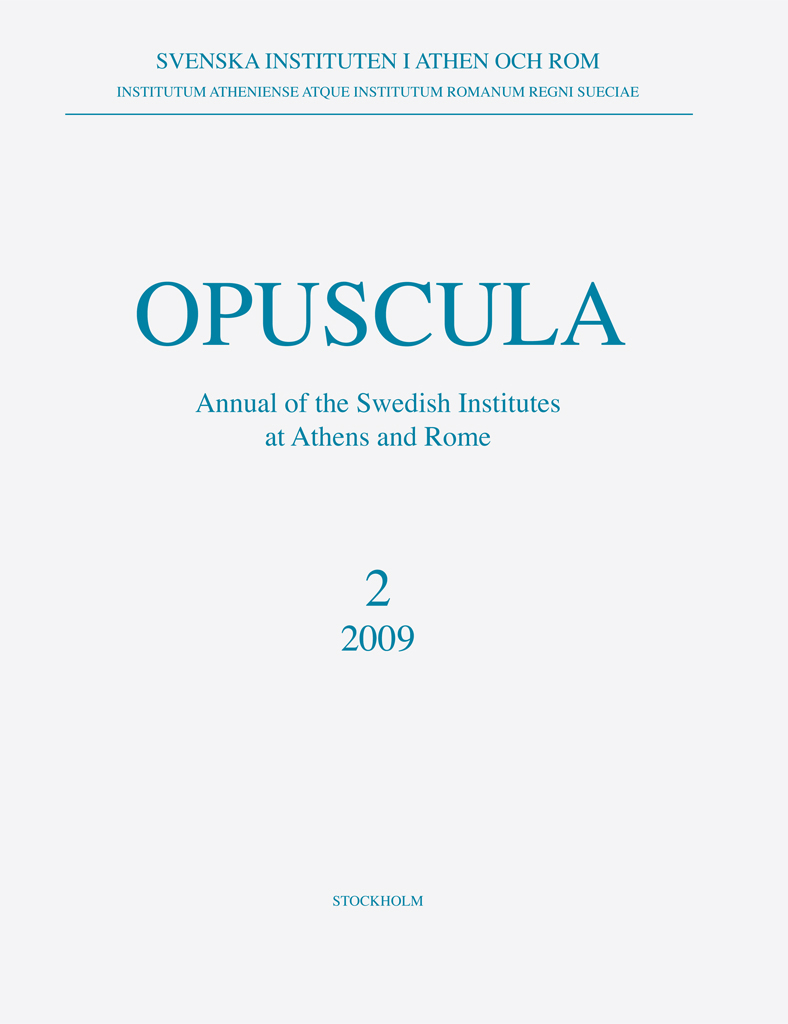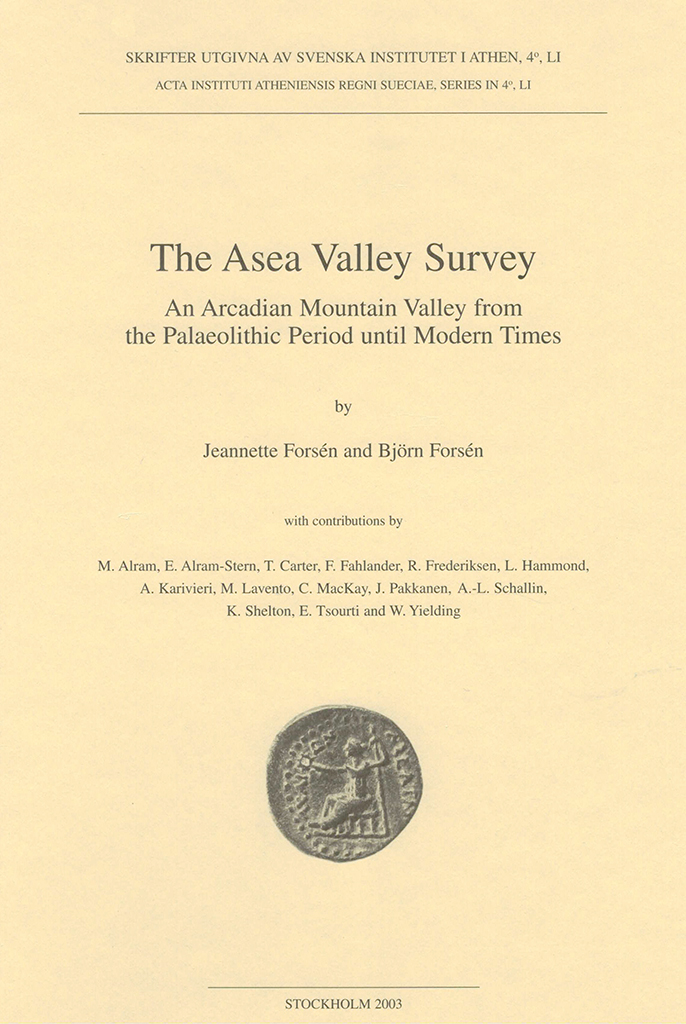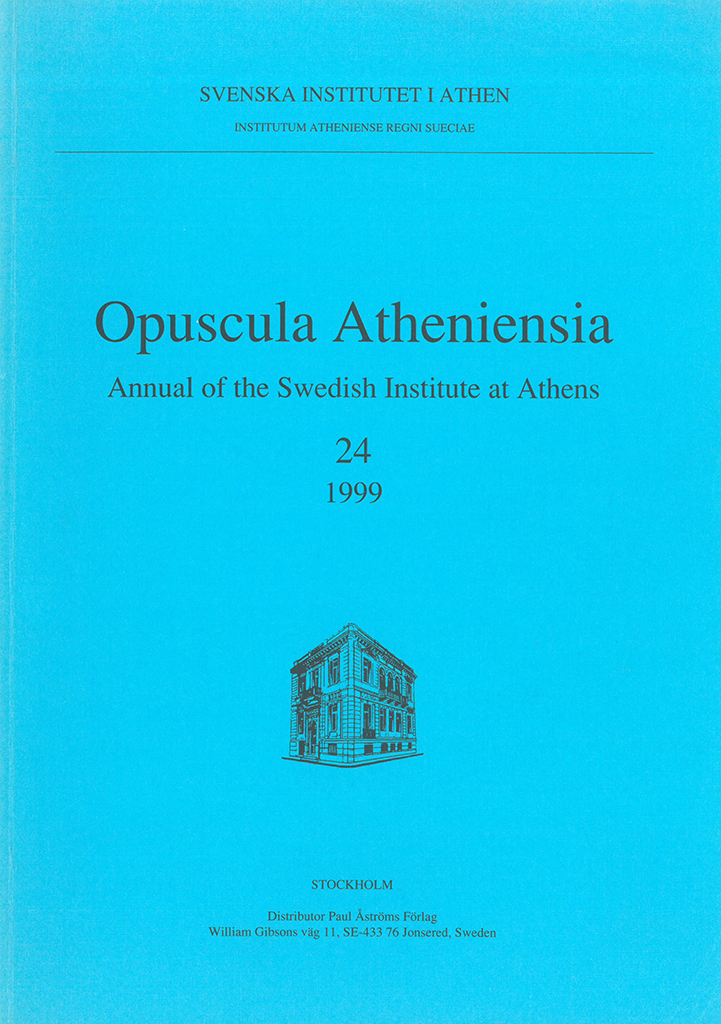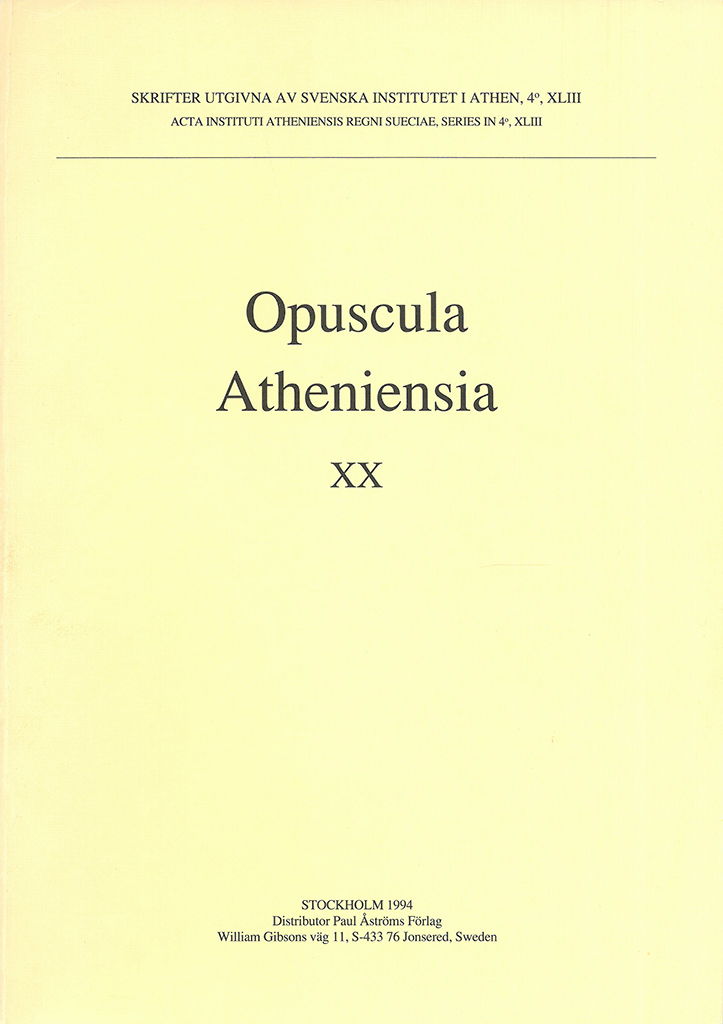Opuscula is published by the Swedish Institutes at Athens and Rome, with the aid of a grant from the Swedish Research Council. Distributed by Eddy.se AB. View journal at ERIH PLUS. All content available with open access. A tale of three drums: an unfinished Archaic votive column in the Sanctuary of Poseidon at Kalaureia By Jari Pakkanen Abstract Three unfinished column drums discovered at the Kalaureia Research Program excavations in 2007–2009 can be shown to have been intended for a monumental Archaic Ionic votive column. All drums have systematic masons’ marks on the contact surfaces. The latter parts of the inscriptions indicate the position of the drum in the shaft. Two alternative readings for the first part of the inscription are suggested: the first interprets it as a building instruction and the second as a price indication. The start of the building project took place very likely in the second half of the sixth century BC, and the deposit date of the fill surrounding the blocks indicates that the unfinished project was abandoned in the late sixth century BC. Reconstruction of the column shaft from the known drum dimensions demonstrates that the finished shaft would have been constructed with a…
Opuscula is published by the Swedish Institutes at Athens and Rome, with the aid of a grant from the Swedish Research Council. Distributed by Eddy.se AB. View journal at ERIH PLUS. All content available with open access. A new inscribed statue base from the Sanctuary of Poseidon at Kalaureia By Jenny Wallensten & Jari Pakkanen Abstract In the Kalaureia Research Program excavations of 2007 and 2008, four joining blocks of a statue base were unearthed. The monument is a dedication from the polis of Arsinoe in the Peloponnese: its inhabitants offered two statues, of King Ptolemaios and his sisterwife Arsinoe Philadelphos, to Poseidon. The present article publishes the monument and its inscription, and proceeds to present a reconstruction and an attempt at positioning the monument in its historical context. Bibliographical information Jenny Wallensten & Jari Pakkanen, ‘A new inscribed statue base from the Sanctuary of Poseidon at Kalaureia’, Opuscula. Annual of the Swedish Institutes at Athens and Rome (OpAthRom) 2, 155–165. Stockholm 2009. ISSN: 2000-0898. ISBN: 978-91-977798-1-4. Softcover, 232 pages. https://doi.org/10.30549/opathrom-02-07
Opuscula is published by the Swedish Institutes at Athens and Rome, with the aid of a grant from the Swedish Research Council. Distributed by Eddy.se AB. View journal at ERIH PLUS. All content available with open access. Report on the excavations in the years 2007 and 2008 southeast of the Temple of Poseidon at Kalaureia By Arto Penttinen and Berit Wells (†). With contributions by Dimitra Mylona, Petra Pakkanen, Jari Pakkanen, Arja Karivieri, Anne Hooton and Emanuel Savini, and with an appendix by Tatiana Theodoropoulou. Abstract Archaeological material ranging in date from the Early Bronze Age to Late Antiquity was found in 2007 and 2008 in the excavations in Area H to the south and southeast of the Temple of Poseidon. Finds datable to the periods of major change in the Sanctuary—the Late Archaic and the Early Hellenistic—illuminate the character of the change. In the Late Archaic period an attempt to erect a votive column at the site was for some reason given up, and drums of large dimensions were left visible, possibly as a reminder of the failure. The construction of a monumental drain next to the Archaic peribolos of the Temple of Poseidon in the early third century…
Published by the Swedish Institute at Athens. Distributed by Astrom Editions. The Asea Valley Survey. An Arcadian mountain valley from the Paleolithic period until modern times By Jeannette Forsén & Björn Forsén, with contributions by Michael Alram, Eva Alram-Stern, Tristan Carter, Fredrik Fahlander, Rune Frederiksen, Leslie Hammond, Arja Karivieri, Mika Lavento, Camilla MacKay, Jari Pakkanen, Ann-Louise Schallin, Kim S. Shelton, Eos Tsourti & Wendy Yielding Abstract This volume presents the finds of the Asea Valley Survey (AVS) carried out 1994–1996 in a mountain valley of Arcadia with the acropolis of Asea, the Palaeokastro, as its focal point. During these three seasons of archaeological surface survey 18.7 km2 of the valley were searched intensively in foot. Artefacts spanning from the Middle Palaeolithic period to the early 19th century were systematically collected and documented. Concurrently a geological team gathered data concerning the ever-changing landscape of the valley. By combining new archaeological and geological data with ancient, Byzantine, Ottoman and Venetian written sources the diachronic history of the Asea valley was reconstructed. Through the discovery of a Middle–Upper Palaeolithic site the regional history has been pushed back to about 50,000 BP. Furthermore, a handful of Early–Middle Neolithic lakeside sites, which produced nothing but…
Published by the Swedish Institute at Athens. Distributed by Astrom Editions. Opuscula Atheniensia. Annual of the Swedish Institute at Athens 24, 1999 Contents Donald W. Jones | The archaeology and economy of Homeric gift exchange Donald W. Jones | The conundrum of Greek population growth in the 8th century B.C. Burials, settlements, and wells Jane F. Lloyd | The three-dimensional form of the light area of the Minoan hall system and the southeast corner of the South Hous at Knossos Jari Pakkanen | Defining the possible column shaft height range and profile. A case study based on the temple of Zeus at Labraunda Eva Rystedt | No words, only pictures. Iconography in the transition between the Bronze Age and the Iron Age in Greece Zofia Stos-Gale, Maria Kayafa & Noel Gale | The origin of metals from the Bronze Age site of Nichoria Lars Walløe | Was the disruption of the Mycenaean world caused by repeated epidemics of bubonic plague? Book reviews Jeannette Forsén | E. Christmann, Die Deutschen Ausgrabungen auf der Pevkakia-Magula in Thessalien II. Die Frühe Bronzezeit Jeannette Forsén | J.B. Rutter, Lerna III. The pottery of Lerna IV Michael Wedde | K. Sbonias, Frühkretische Siegel. Ansätze für…
Published by the Swedish Institute at Athens. Distributed by Astrom Editions. Opuscula Atheniensia 20 Contents Articles Diane L. Bolger, ‘Engendering Cypriot archaeology: female roles and statuses before the Bronze Age’ Katie Demakopoulou, Nicolletta Divari-Valakou & Gisela Walberg, ‘Excavations and restoration work in Midea 1990–1992’ Björn Forsén, ‘Marmorne Gewichtsteine aus Thera’ David Frankel & Jennifer M. Webb, ‘Hobs and hearths in Bronze Age Cyprus’ Carole Gillis, ‘Binding evidence. Tin foil and organic binder on Aegean Late Bronze Age pottery’ Vassos Karageorghis, ‘Monkeys and bears in Cypriot art’ Jane F. Lloyd, ‘A clay triton shell in a private collection in New York’ Erik Østby, Jean-Marc Luce, Gullög C. Nordquist, Chiara Tarditi & Mary E. Voyatzis, ‘The sanctuary of Athena Elea at Tegea: first preliminary report (1990–1992)’ Jari Pakkanen, ‘Accuracy and proportional rules in Greek Doric temples’ Edgar Peltenburg, ‘Constructing authority: the Vounos enclosure model’ Claus Reinholdt, ‘”ΝΟΣΤΟΣ ΌΔΥΣΣΗΙ” oder Vita Humana? Zu einem Vasenbild des Schweinemalers in Cambridge’ Paavo Roos, ‘In search of ancient stadia and hippodromes in Anatolia’ Ilse Schoep, ‘”Home sweet home”. Some comments on the so-called house models from the prehellenic Aegean’ Eva Toivonen Skage, ‘Supplementary sherds from Ayos Jakovos Tomb 9, Dromos’ Eberhard Zangger, ‘The island of Asine:…




